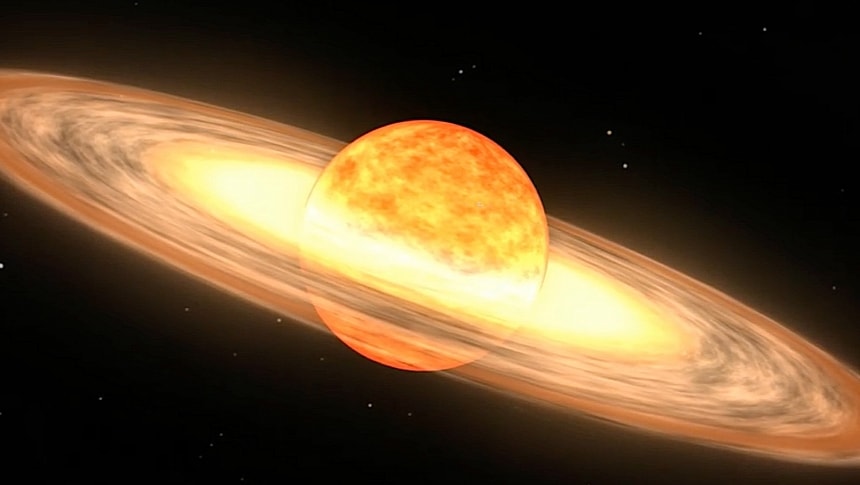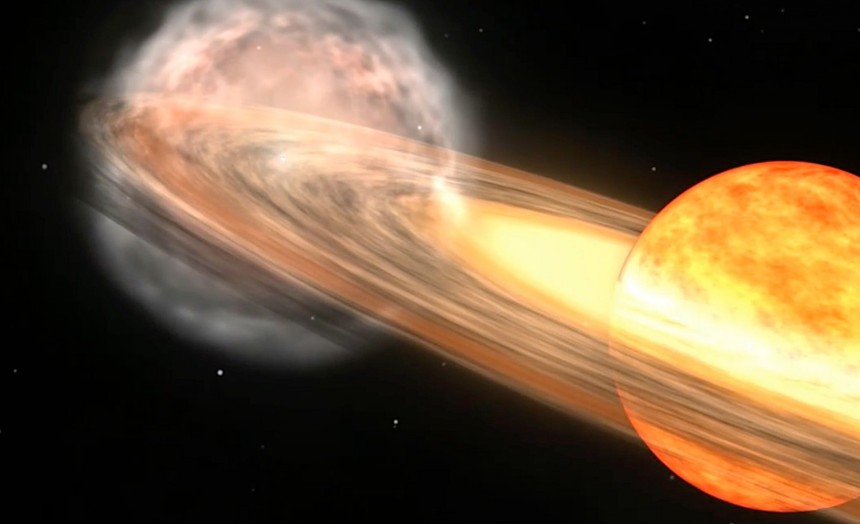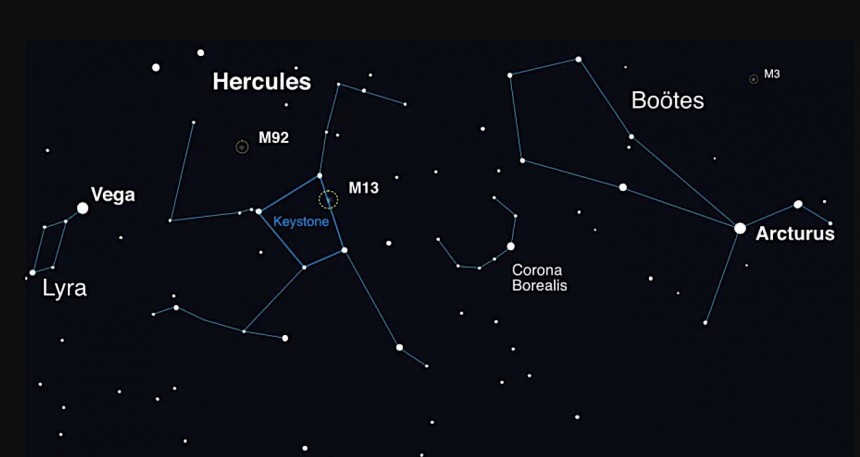The sky as seen from our planet is a fascinating place if you don't give it much thought, but if you really think about it, there's not much going on up there. The multitude of stars visible from Earth has occupied the same place for eons, planets are not generally visible from here, and no alien spaceship has come our way so far. So when hearing a nova is about to occur, and that it will be visible from Earth, human hearts are poised to start beating a bit harder.
Nova is the term we use to describe sudden bursts of light in the sky, caused by the eruption of accumulated star material as a result of a sudden, thermonuclear explosion. In turn, the explosion is caused by the accumulation of hydrogen on the surface of the star.
Unlike supernovae, which are the last manifestations of dying stars and catastrophic events, novae occur regularly over periods of thousands of years, because the star itself is not destroyed in the process. And if the conditions are right, we humans get a chance to experience such events for ourselves.
I'm not sure how many of you have heard about a place called T Coronae Borealis (T CrB). Also known as the Blaze Star, it is a binary system in the Northern Crown region, 3,000 light years from our world. It's home to a white dwarf and a red giant.
The red giant, an ancient star, is being stripped of hydrogen by the gravitational pull of the white dwarf, and the stuff accretes on the smaller star's surface until it can't take any more pressure and heat. Every 80 years or so, the white dwarf erupts in a glorious thermonuclear explosion that is visible from Earth.
The first time humanity learned of this nova's existence was in 1217, and we know that thanks to an account by a German abbot named Burchard. The last time the place exploded was in 1946, meaning there's a very big chance, according to astronomers, for it to do it again by September this year.
The prediction is supported by the fact that the white dwarf behaves the same way it did before exploding after the end of the Second World War. The most tell-tale sign: a dark spot in the region of the sky where the star is located.
If it goes off, the nova will become a "once-in-a-lifetime event" because, despite its regularity, the explosion barely happens often enough for human beings to be able to experience it twice during their lifetimes.
The fact that the nova is located relatively close to our planet makes it a prime target for study. Astronomers will have to be fast on their feet, though, as the event won't be visible for more than a week.
Knowing the event is coming, NASA gave us a few pointers on where in the sky to look – a fair warning, though, as following these instructions is no possible without some basic knowledge of the night sky.
First, we should locate the Northern Crown, a horseshoe-shaped collection of stars west of the Hercules constellation. To do that, you need to first look at the two brightest stars in the Northern hemisphere, Arcturus and Vega. One needs to track an imaginary straight line from one to the other, and this exercise will reveal the location of the Corona Borealis.
A number of telescopes, both ground- and space-based, will be pointed at the distant white dwarf in the coming months, including the Fermi Gamma-ray Space Telescope, the James Webb Space Telescope, and the Neil Gehrels Swift Observatory, among others.
They will be used to capture data across the visible and non-visible light spectrum, but, for the first time ever, they will also look at the event using gamma ray imagers, a piece of technology that was not available in 1946.
NASA and the larger astronomer community also rely on the larger public to gather information about the nova, especially during its early stages.
When the event is over and all the data is in, people will start combing through it in the hopes of learning more about "the structure and dynamics of recurring stellar explosions like this one." Then, more insight into the lifecycles of binary systems and their internal process could also be gained.
Although all of the above sounds exciting and all, there is a small chance September will come and pass without T CrB blowing up.
"Recurrent novae are unpredictable and contrarian," said Dr. Koji Mukai, a fellow astrophysics researcher at NASA Goddard. "When you think there can't possibly be a reason they follow a certain set pattern, they do – and as soon as you start to rely on them repeating the same pattern, they deviate from it completely. We'll see how T CrB behaves."
Unlike supernovae, which are the last manifestations of dying stars and catastrophic events, novae occur regularly over periods of thousands of years, because the star itself is not destroyed in the process. And if the conditions are right, we humans get a chance to experience such events for ourselves.
I'm not sure how many of you have heard about a place called T Coronae Borealis (T CrB). Also known as the Blaze Star, it is a binary system in the Northern Crown region, 3,000 light years from our world. It's home to a white dwarf and a red giant.
The red giant, an ancient star, is being stripped of hydrogen by the gravitational pull of the white dwarf, and the stuff accretes on the smaller star's surface until it can't take any more pressure and heat. Every 80 years or so, the white dwarf erupts in a glorious thermonuclear explosion that is visible from Earth.
The prediction is supported by the fact that the white dwarf behaves the same way it did before exploding after the end of the Second World War. The most tell-tale sign: a dark spot in the region of the sky where the star is located.
If it goes off, the nova will become a "once-in-a-lifetime event" because, despite its regularity, the explosion barely happens often enough for human beings to be able to experience it twice during their lifetimes.
The fact that the nova is located relatively close to our planet makes it a prime target for study. Astronomers will have to be fast on their feet, though, as the event won't be visible for more than a week.
Knowing the event is coming, NASA gave us a few pointers on where in the sky to look – a fair warning, though, as following these instructions is no possible without some basic knowledge of the night sky.
First, we should locate the Northern Crown, a horseshoe-shaped collection of stars west of the Hercules constellation. To do that, you need to first look at the two brightest stars in the Northern hemisphere, Arcturus and Vega. One needs to track an imaginary straight line from one to the other, and this exercise will reveal the location of the Corona Borealis.
They will be used to capture data across the visible and non-visible light spectrum, but, for the first time ever, they will also look at the event using gamma ray imagers, a piece of technology that was not available in 1946.
NASA and the larger astronomer community also rely on the larger public to gather information about the nova, especially during its early stages.
When the event is over and all the data is in, people will start combing through it in the hopes of learning more about "the structure and dynamics of recurring stellar explosions like this one." Then, more insight into the lifecycles of binary systems and their internal process could also be gained.
Although all of the above sounds exciting and all, there is a small chance September will come and pass without T CrB blowing up.
"Recurrent novae are unpredictable and contrarian," said Dr. Koji Mukai, a fellow astrophysics researcher at NASA Goddard. "When you think there can't possibly be a reason they follow a certain set pattern, they do – and as soon as you start to rely on them repeating the same pattern, they deviate from it completely. We'll see how T CrB behaves."








